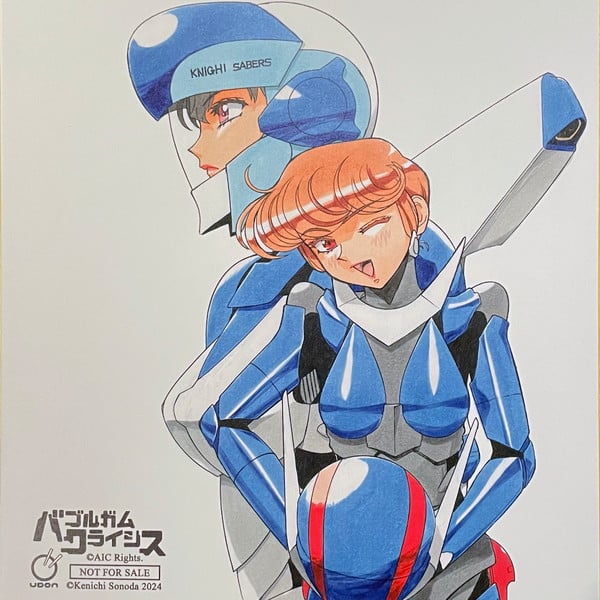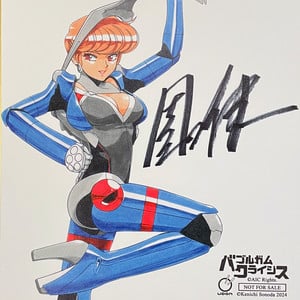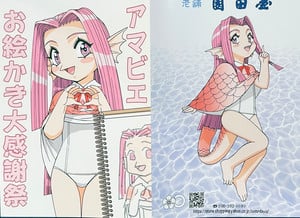When Old Work Reaches New Audiences: An Interview with Bubblegum Crisis' Kenichi Sonoda
by Kalai Chik,
Kenichi Sonoda, Japanese manga artist and character designer for Bubblegum Crisis, returned to the US for his appearance at San Diego Comic-Con 2024. Udon Entertainment brought him as a guest in celebration of Bubblegum Crisis Complete Archive, which includes an extensive collection of production art for the 1987 anime series. During his time at SDCC, Comic-Con International awarded him an Inkpot Award, given to distinguished professionals for their contributions to pop culture. Joined by translator Dan Kanemitsu, Sonoda-sensei spoke about what's been keeping him busy.
Could you please introduce yourself?
Kenichi Sonoda: I finished doing Bullet the Wizard in Monthly Afternoon about 10 years ago. Since then, I haven't done any manga. I've been doing different projects, such as contributing materials to crowdfunded reissues of old anime that AnimEigo has been conducting. So, that is something that I have contributed to relatively recently.
Is this your first time at San Diego Comic-Con?
Sonoda: I think this is the first time I've gone to SDCC, but I'm not sure.
Have you been able to talk to fans of Bubblegum Crisis and Gunsmith Cats?
Sonoda: Yes, I had an opportunity to talk to many fans at San Diego Comic-Con, and I had a wonderful time doing it.

Sonoda: I think from a younger person's perspective, old material may be just new and refreshing to them. So, the selection of a new art style, retro, is not necessarily retro, but it's just one of the many different types of self-expression that are available. It's not necessarily old; it's just a different style. Another thing to keep in mind is that many artists, mangaka, and character designers are extraordinarily accomplished in their ability to draw. Even material that's created by old hands such as Mitsuteru Yokoyama (who drew the Three Kingdoms manga) and Satoru Ozawa (who drew Submarine 707) has been reinvigorated by younger creators. They have reimagined the designs in their new style. That has opened up new realms of expression.
During your time in the anime and the manga industry, you were also running a family business. For people who want to get into anime and manga but also have other responsibilities, what would you say to them based on your own experience?
Sonoda: I would say that retaining employment in a non-otaku industry is probably financially and physically healthier. However, for some of us who are extraordinarily creative and who have to pursue a line in this career, just do it. Once you have jumped into this industry, you just have to best navigate it as possible. It is not an easy path to take. You have to make sure that you're willing to take that dedication to the next level.
You drew new art for Udon's release of Bubblegum Crisis Complete Archive. How does it feel to revisit the character designs again?
Sonoda: If it's something I did long ago, truth be told, I forget. Revisiting the designs I created many, many years ago, I have to review and look at the reference material. It's a refreshing process, and I discover new things about their designs. Even today, while I'm doing sketches for different people, I have to use my smartphone to look at different reference points because there are some details I tend to forget over the years.
Are you still largely drawing traditionally, or have you transitioned to more digital tools now?
Sonoda: Overall, I'm still an analog guy. I still use my hands, and I still draw on paper. But for color works, I use Copic markers for those illustrations. For the most part, in cel-style artwork with solid colors, like with anime cels, I do the line art, scan it, and have an assistant color it based on instructions I provide. This is not that different, although this is using a computer process now. This breakdown of labor between line art, coloring instructions, and having it physically colored is no different from how it's been done with cel works for many years.
Manga Artist Thoughts on the Retro Anime Craze pic.twitter.com/E371X2lfe9
— Anime News Network (@Anime) August 21, 2024
Dark Horse announced a release of Gunsmith Cats, and fans are incredibly happy because it's so hard to get a hold of the older copies. What do you think about the fact that there are still so many die-hard fans of Gunsmith Cats?
Sonoda: I'm very glad that this allows my work to reach new audiences. Also, hopefully, it will provide something relaxing and comfortable for older fans to enjoy.
Speaking of which, technology has really changed since Gunsmith Cats was originally published 33 years ago. Do you think Rally would update her taste in cars? Would she drive an electric vehicle?
Sonoda: I'm the type of person who doesn't put a lot of faith in how EV cars work. This is my conviction, but in American action film franchises, the main protagonist feels better suited to drive around a muscle car. I like V8-engine cars.
If Rally could get a new car, what car do you think she'd get?
Sonoda: I suppose she would probably pick up a relatively new Ford Mustang, a Dodge Charger, a Dodge Challenger, or a Chevrolet Camaro.
Interestingly, Marvel movies have the heroes driving Audi cars, and Bruce Wayne drives a Mercedes-Benz. I know it's like a marketing tactic.
Sonoda: It's amazing that it's an American film franchise, but why aren't they driving US cars?
I think most of the American cars are in the Fast and Furious franchise.

As a special treat, Sonoda-sensei brought a bag from his family's confectionery shop, Sonoda-ya. He's the 19th head of the family business, and he drew an amabie (アマビエ) as a promotion. The character is a maritime creature that appears in front of fishermen and says, “In times of a plague, draw illustrations on me, and the plague will be lifted.” He had other artists contribute illustrations to the leaflet as well. If you're ever in Kumamoto, feel free to stop by for some traditionally chosen ame.
discuss this in the forum (10 posts) |
this article has been modified since it was originally posted; see change history